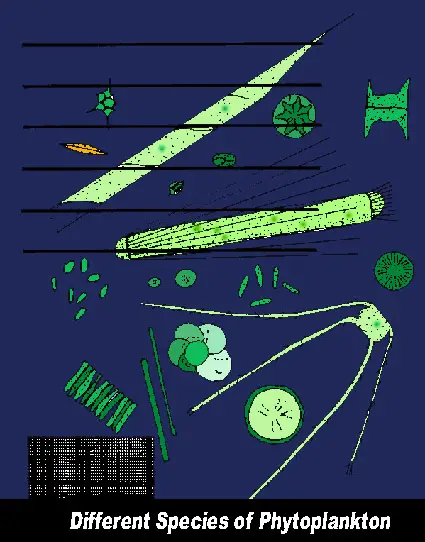Phytoplankton are microscopic plants that live in the ocean. The name comes from Greek terms, phyton or “plant” (“planktos”), meaning “wanderer” or “drifter”. The plant life is generally too small to be individually seen with the unaided eye. However, when present in high enough numbers, they can appear as a green discoloration of the water due to the presence of chlorophyll within their cells (colour may vary with the plant species).
There are many species, each of which has a characteristic shape. Collectively, they grow abundantly in oceans around the world and are the foundation of the marine food chain. Small fish, and some species of whales, consume them as food, then larger fish eat the smaller fish, and we then catch and eat many of these larger fish. Since this plant life depends upon certain conditions for growth, they are a very good indicator of changes in the environment.

For these reasons, and because they also exert a global scale influence on climate, there are of primary interest to oceanographers and Earth scientists around the world.
These tiny plants use carbon dioxide in photosynthesis, and the bigger the total population, the more carbon dioxide gets pulled from the atmosphere. Scientists have found that a given population of phytoplankton can double in number, on the order of once per day. In other words, phytoplankton respond very rapidly to changes in their environment. Large populations of this little organism, sustained over long periods of time, could significantly lower atmospheric carbon dioxide levels and, in turn lower average global temperatures.
The plants depend upon sunlight, water, and nutrients to survive. Any physical or chemical variation in these components will impact on the populations of this marine plant, and they will flourish or diminish quickly in response to changes in environment. Changes in the trends for a given population, such as, density, distribution, and rate of population growth or diminishment, can alert scientists that environmental conditions are changing there.
By comparing these trends to other measurements, such as temperature, scientists can learn more about how these plants may be contributing to and affected by, climate and environmental change.
To human eyes, the ocean appears as shades of blue; sometimes blue-green. However, from outer space, satellite sensors can distinguish even slight variations in color to which our eyes are not sensitive. Different shades of ocean color reveals the presence of differing concentrations of sediments, organic materials such as these plants, all of which can be measured by satellites. Due to their pigmentation by chlorophyll, the plant matter absorbs the red and blue portions of the light spectrum (for photosynthesis) and reflect green light. So, the ocean over regions with high concentrations of phytoplankton will appear as certain shades, from blue-green to green, depending upon the type and density of the population there.

This sequence of ocean color images above shows the impact of a recent El Niño on the productivity of around the Galapagos Islands in the Pacific Ocean. The far left image was taken during the height of the 1997-98 El Niño, while the far right image was taken during a more recent La Niña. Note the gradually flourishing bloom of phytoplankton as the surface waters cool, allowing the deeper, more nutrient-rich waters to upwell. (Courtesy of the SeaWiFS Project)
